Refine listing
Actions for selected content:
17000 results
Acknowledgements
-
- Book:
- Structures in the Universe by Exact Methods
- Published online:
- 20 January 2010
- Print publication:
- 22 October 2009, pp xiv-xiv
-
- Chapter
- Export citation
Frontmatter
-
- Book:
- Structures in the Universe by Exact Methods
- Published online:
- 20 January 2010
- Print publication:
- 22 October 2009, pp i-vi
-
- Chapter
- Export citation
I - THEORETICAL BACKGROUND
-
- Book:
- Structures in the Universe by Exact Methods
- Published online:
- 20 January 2010
- Print publication:
- 22 October 2009, pp 9-10
-
- Chapter
- Export citation
7 - CMB temperature fluctuations
- from II - APPLICATIONS OF THE MODELS IN COSMOLOGY
-
- Book:
- Structures in the Universe by Exact Methods
- Published online:
- 20 January 2010
- Print publication:
- 22 October 2009, pp 189-208
-
- Chapter
- Export citation
Index
-
- Book:
- Structures in the Universe by Exact Methods
- Published online:
- 20 January 2010
- Print publication:
- 22 October 2009, pp 228-242
-
- Chapter
- Export citation
8 - Conclusions
- from II - APPLICATIONS OF THE MODELS IN COSMOLOGY
-
- Book:
- Structures in the Universe by Exact Methods
- Published online:
- 20 January 2010
- Print publication:
- 22 October 2009, pp 209-216
-
- Chapter
- Export citation
6 - The horizon problem
- from II - APPLICATIONS OF THE MODELS IN COSMOLOGY
-
- Book:
- Structures in the Universe by Exact Methods
- Published online:
- 20 January 2010
- Print publication:
- 22 October 2009, pp 184-188
-
- Chapter
- Export citation
II - APPLICATIONS OF THE MODELS IN COSMOLOGY
-
- Book:
- Structures in the Universe by Exact Methods
- Published online:
- 20 January 2010
- Print publication:
- 22 October 2009, pp 89-90
-
- Chapter
- Export citation
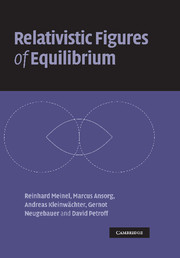
Relativistic Figures of Equilibrium
-
- Published online:
- 22 October 2009
- Print publication:
- 26 June 2008
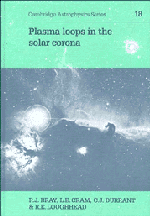
Plasma Loops in the Solar Corona
-
- Published online:
- 22 October 2009
- Print publication:
- 18 July 1991
Foreword
-
- Book:
- Structures in the Universe by Exact Methods
- Published online:
- 20 January 2010
- Print publication:
- 22 October 2009, pp xi-xiii
-
- Chapter
- Export citation
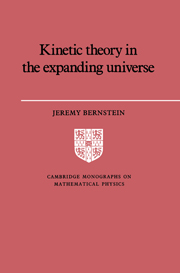
Kinetic Theory in the Expanding Universe
-
- Published online:
- 20 October 2009
- Print publication:
- 26 August 1988
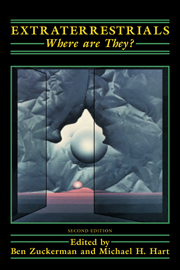
Extraterrestrials
- Where Are They?
-
- Published online:
- 20 October 2009
- Print publication:
- 28 September 1995
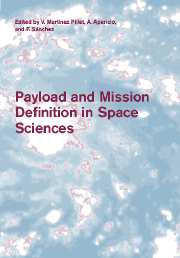
Payload and Mission Definition in Space Sciences
-
- Published online:
- 19 October 2009
- Print publication:
- 17 November 2005
18 - Kundt solutions
-
- Book:
- Exact Space-Times in Einstein's General Relativity
- Published online:
- 04 February 2010
- Print publication:
- 15 October 2009, pp 336-360
-
- Chapter
- Export citation
Appendix B - 3-spaces of constant curvature
-
- Book:
- Exact Space-Times in Einstein's General Relativity
- Published online:
- 04 February 2010
- Print publication:
- 15 October 2009, pp 470-476
-
- Chapter
- Export citation
1 - Introduction
-
- Book:
- Exact Space-Times in Einstein's General Relativity
- Published online:
- 04 February 2010
- Print publication:
- 15 October 2009, pp 1-4
-
- Chapter
- Export citation
2 - Basic tools and concepts
-
- Book:
- Exact Space-Times in Einstein's General Relativity
- Published online:
- 04 February 2010
- Print publication:
- 15 October 2009, pp 5-26
-
- Chapter
- Export citation
9 - Space-times related to Schwarzschild
-
- Book:
- Exact Space-Times in Einstein's General Relativity
- Published online:
- 04 February 2010
- Print publication:
- 15 October 2009, pp 127-168
-
- Chapter
- Export citation
Contents
-
- Book:
- Exact Space-Times in Einstein's General Relativity
- Published online:
- 04 February 2010
- Print publication:
- 15 October 2009, pp vii-xiv
-
- Chapter
- Export citation
